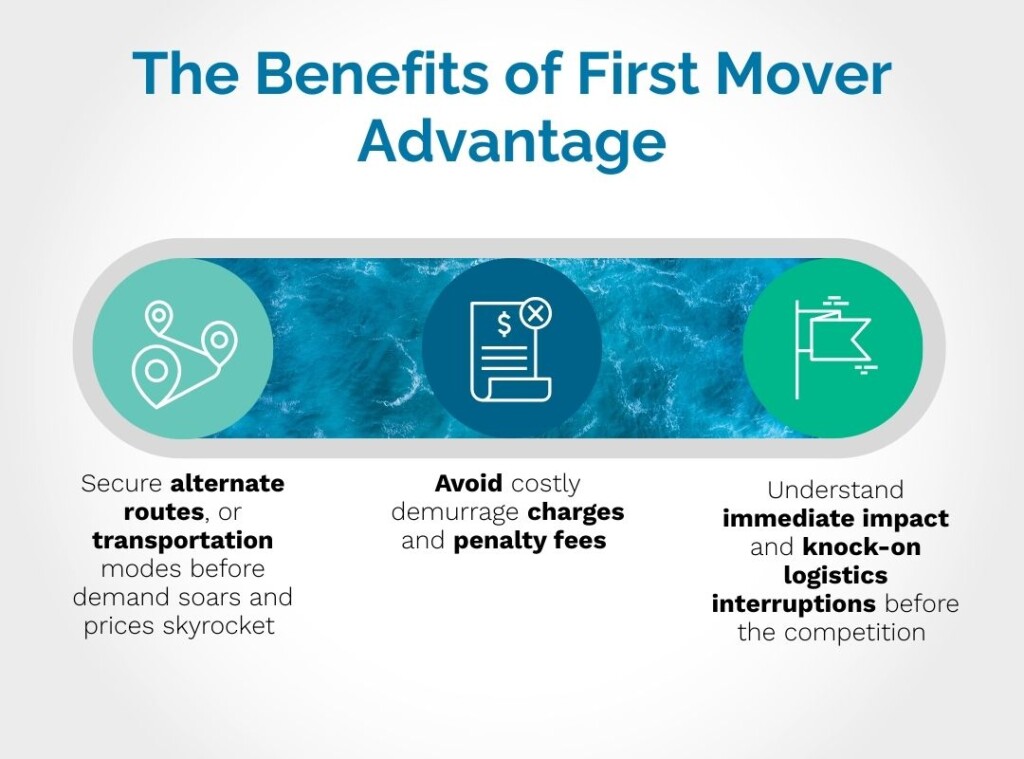The value of logistics risk management is in dollars and cents. Yes, risk-optimized logistics does mean greater agility or resilience too, but the most important considerations are costs saved, and costs avoided.
Luckily for logistics professionals, most shipments make it from A to B without a hitch. However, when things do go wrong, it takes a lot of time, effort – and usually, money – to fix them.
That is because delayed or missing shipments can have significant impacts beyond penalty fees and unhappy customers. They can result in production delays, which leads to lost sales, which in turn, can lead to lost market share.
What if you could know beforehand which shipments were at risk of missing their delivery deadline, and by how much?
Imagine if you could see the risk beforehand and plan around it?
Some risks may be unavoidable, such as the large-scale disruption caused by the Suez Canal blockage. But what if you knew the impact on your shipments before anyone else? When very disruptive events occur, thousands of organizations scramble for the same resources. This results in capacity constraints, along with skyrocketing rates.
The real value in predicting logistics risk comes down to cost. Avoiding a threat to operations or being quick to address an issue when it arises has a significant impact not just on the cost of a single shipment, but your overall logistics spend.
How Predictable is Logistics Risk?
It may seem that logistics risk is very hard to predict. But that is not necessarily true. Certain events may be difficult to predict, but their impact on logistics is not.
For the past number of years manufacturers have faced unprecedented events that threatened to upend operations because of supply chain disruption. Humans are not great at imagining unlikely events. Few people could have foreseen that a ship would get stuck in the Suez Canal, or that a ship would plough into the Baltimore bridge.
Then there are rare events like the 2025 Kamchatka earthquake struck the Russian Far East. Although far less destructive than most earthquakes of its magnitude, the subsequent tsunami warning sent Pacific logistics into disarray.
Logistic disruptions can be broadly divided into three categories:
- Unforeseen events
- Events with unpredictable timing
- Predictable events with predictable disruption timing
Unforeseen Events
Unforeseen events are impossible to predict. These can include unprecedented “black swan” events that can cause widespread disruption, but they also include unpredictable natural disasters, such as earthquakes.
Events with Unpredictable Timing
Some disruptions are either inevitable or extremely likely. For example, if you live in an area prone to wildfires, you will know that they are likely to occur. What you don’t know is the exact location or timing of the wildfires, nor how they may affect your logistics operation.
Predictable Events with Predictable Disruption Timing
Many disruptions are predictable. Take hurricanes for example. These happen every year. When a hurricane is brewing, meteorologists can predict if it will make landfall, and where and when this will be.
Logistics Risk and Unforeseen Events
Large, unforeseen global disruptions are widely reported. Therefore, you do not need a heads up that they are happening. You will also know that if they happen in a region where you operate, that you can expect logistics disruptions.
So, why would you need logistics risk management?
There are three very good reasons.
Firstly, newspaper sources will not give you any information on which of your materials and shipments have been, or will be, impacted by the disruption.
Secondly, newspapers will not necessarily have insight into how a large-scale disruption could create knock-on threats to logistics and supply chain operations in general.
Finally, no publicly available information will have the predictive sensing to inform you that these follow-on threats are likely to impact your logistics operations specifically.
If supply chain chaos is inevitable, being quick to respond gives you a significant advantage. According to McKinsey, it takes organizations, on average, two weeks to respond to a major supply chain disruption.
If you are forewarned, you have a first mover advantage. You can secure alternative routes or modes at a much lower rate before demand spikes, as well as avoid high demurrage charges or potential penalties.

Figure 1: The faster you react to a disruptive event, the better placed you are to avoid higher costs and stuck shipments
Logistics Risk and Events with Unpredictable Timing
Like unpredictable events, events with unpredictable timing can cause chaos for many organizations, including your competitors. Similarly, while the timing of the event is not predictable, it is possible to know early on how this will impact on your shipments.
Such events include the growing problem of cyber-attacks. In the past few years, there have been a number of cyber-attacks on ports. These can severely impact operations, for days or even weeks.
Newspapers may report on such events, but this generally happens a few days after the attack. If a cyber-attack happens in China or Vietnam, it could be more than a week before the press in Europe and North America pick up on the news.
More importantly, public reporting does not show you the impact of these events on your own logistics operations.
A risk management solution will outline the immediate threats to your logistics operation. It will also be able to predict looming threats either caused by the original event, or ones that will compound it.
Consider the case of a wildfire. You may know where it is currently, and that authorities have closed a major highway.
So, today’s disruption is road transportation. But what about tomorrow?
Wind patterns can help predict where a wildfire and its smoke will spread. Your logistics management solution will alert you that there is a high risk of disruption in three days at Port A due to smoke. This interruption is also likely to cause congestion and increased dwell times at Port B in four days’ time.
If you are aware of a disruption risk in near real time, as well as looming threats, you again get a first mover advantage.
